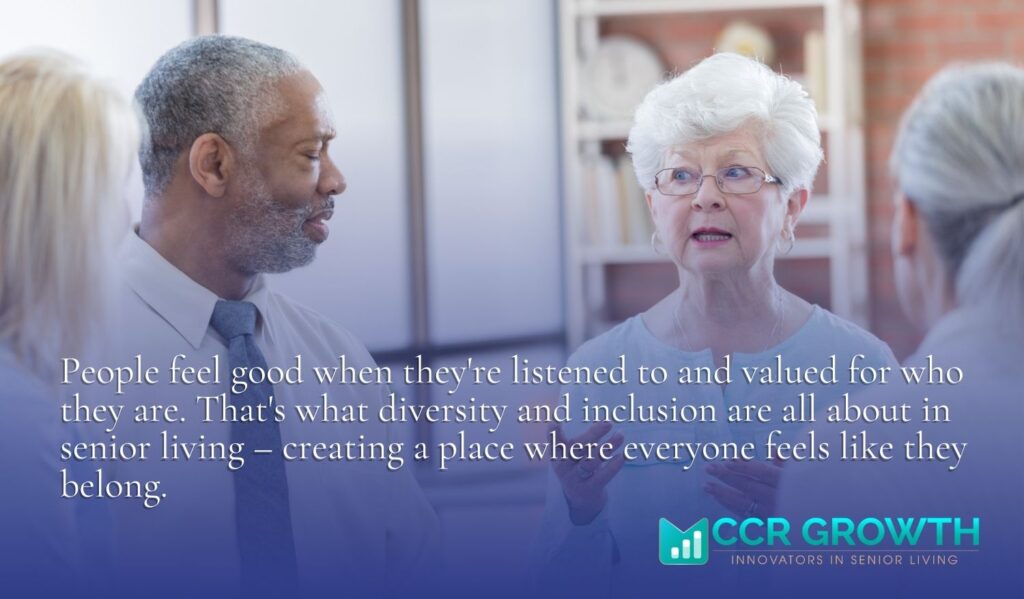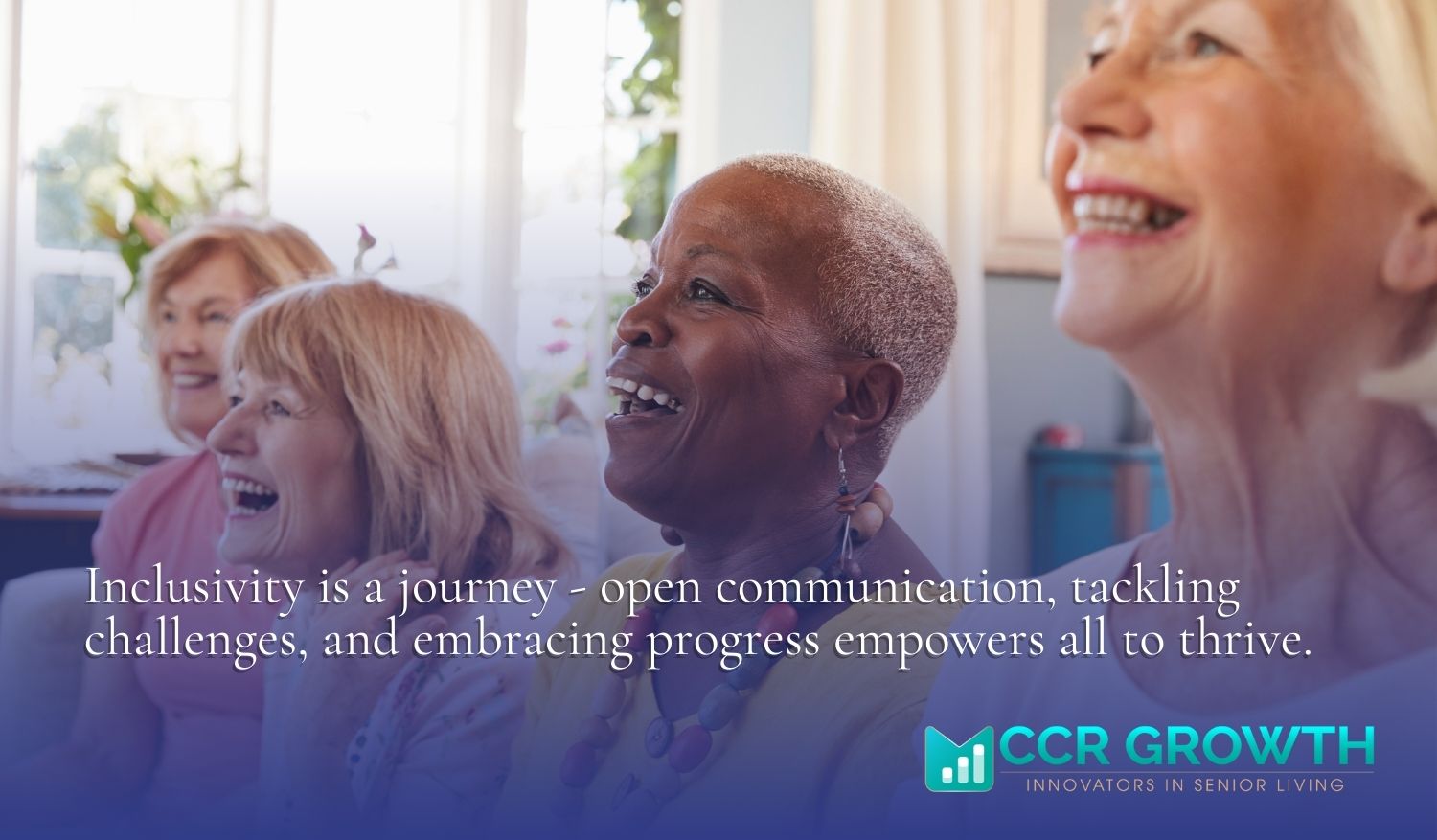
CCR Growth
The Value of Diversity and Inclusion in Senior Living
As senior living communities evolve, the importance of diversity and inclusion has become increasingly evident. These values are essential components that can significantly enhance the quality of life for both residents and staff. In this article, we explore how recognizing and celebrating diverse voices can transform senior living environments, creating richer, more fulfilling experiences for everyone involved.

Understanding the Changes in the Aging Population
The demographics of older adults is shifting and growing, with those over 65 expected to double by 2030, accounting for 20% of the population, and with centenarians predicted to quadruple by 2054. Given the US population is made up of a vast melting pot of cultures and ethnicities, we can expect this to be steadily represented in the aging population in the coming decades, making embracing diversity a necessity for creating a thriving senior living community.
Research by the United States Census Bureau confirms that the population of older adults is more racially and ethnically diverse than ever before, with non-Hispanic, white populations predicted to shrink from 75% to about 60% between 2022 and 2050. Yet, this rise in diversity still does not match the major shift in racial and ethnic make-up of those 18 years and younger, suggesting that we risk a major diversity gap between generations if diversity and inclusivity is not consistently practiced for young and old alike.

Diversity and inclusion in senior living should be about recognizing the multitude of voices, backgrounds, and experiences that make up your resident and staff population, to encourage communication, trust and an overall sense of well-being and belonging for all.
Celebrating Diverse Voices: Residents and Staff
By recognizing and celebrating the unique voices of residents and staff, we unlock a wealth of experiences, perspectives, and traditions. This enriches daily life, fosters a deeper sense of belonging, and combats social isolation. Now, let’s explore some practical ways to weave this vibrant tapestry of voices into the very fabric of a community: Imagine a resident who immigrated from China teaching calligraphy during a resident-led activity, or a staff member with a Nigerian heritage shares their love for high-energy Afrobeat dance classes. You might consider incorporating a “Global Cuisine” program featuring dishes from residents’ – and staff’s – home countries. These are just a few examples of how diverse backgrounds can enrich daily life in a senior living community. The benefits are clear: exposure to different cultures can broaden our perspectives, reduce prejudice, and overall, fosters a sense of belonging.
Shaping Daily Experiences Through Diversity
Diversity isn’t just about celebrating heritage; it’s about weaving it into the fabric of community life. Here are some ways to foster inclusivity through daily activities and experiences:
- Multicultural Events: Celebrate diverse holidays and traditions. Organize international food festivals, film screenings, or cultural talks led by residents or staff members.
- Diverse Activity Offerings: Cater to a variety of interests and abilities. Offer yoga alongside tai chi, or book clubs with a focus on international literature.
- Staff Training: Invest in cultural competency training for staff. This equips them to understand and cater to the needs of diverse residents, fostering stronger connections.
The Rich Tapestry of Resident Stories

Many older adults have lived through incredible historical periods and possess unique cultural knowledge. Oral history like this should be recorded, and shared with younger generations for the benefit of highsight, and understanding. It’s not just about reminiscing. Sharing life stories, especially those lived through pivotal historical moments, empowers older adults to preserve their unique perspective on the past. Listeners gain a deeper understanding of these events, fostering empathy and connection across generations.
It’s a powerful way to bridge the gap between personal experience and historical record, enriching the present with the wisdom of the past. Imagine a resident who witnessed the civil rights movement or a woman who immigrated to the US after World War II. By actively collecting and sharing these stories through resident interviews, community newsletters, or even intergenerational events, we create a vibrant tapestry of lived experiences for everyone to learn from. This practice not only fosters a sense of connection but can also promote emotional well-being and mental stimulation for residents.
Embracing Progressiveness
Building a truly inclusive senior living community requires a commitment to continuous progress. It’s not just about ticking a box or implementing a one-time program – it’s about fostering a culture of respect, understanding, and open communication. Here’s why a progressive approach is essential:
- Unconscious Bias: We all carry unconscious biases, shaped by our upbringing and experiences. Invest in training programs for staff that help them identify and challenge these biases to ensure interactions with residents are fair and respectful.
- Lack of Awareness: Residents may not be familiar with different cultures or traditions. Organize awareness groups or resident-led discussions to foster curiosity, understanding, and appreciation for diversity.
- Open Communication Channels: Create a safe space for residents and staff to voice concerns or ask questions about diversity and inclusion. Regularly solicit feedback through surveys, focus groups, or suggestion boxes to identify areas for improvement.
Moving beyond traditional training sessions, consider incorporating diversity and inclusion initiatives into the everyday life of your community. Embracing inclusivity is an ongoing journey. By acknowledging challenges, fostering open communication, and implementing progressive practices, you can create a senior living community that celebrates the richness of human experience and empowers everyone to thrive.
Practical Steps for Enhancing Diversity and Inclusion

Here are some concrete steps to get you started in your senior living community:
- Diversity Audit: Before diving into inclusivity efforts, a diversity audit can be your guiding light. It’s a systematic assessment of your senior living community’s inclusivity practices. Imagine examining resident and staff demographics, policies, and the overall culture to identify areas for improvement. The process involves defining goals, collecting data (resident/staff demographics, policies, feedback), analyzing the information, and creating an action plan. This provides a baseline, identifies opportunities, guides future efforts, and promotes accountability. By auditing regularly, you ensure continuous progress towards a more welcoming and inclusive community.
- Staff Recruitment: Actively recruit staff from diverse backgrounds to reflect the community you serve. Attracting a diverse staff is key to building an inclusive senior living community. Widen your net by advertising on targeted job boards and partnering with diverse organizations. Craft inclusive job descriptions that highlight your commitment to diversity. During interviews, seek candidates with cultural competency. Invest in training for all staff on cultural sensitivity and consider language courses to bridge communication gaps. Celebrate your team’s diversity and foster a sense of belonging through employee resource groups. These efforts will enrich your staff culture and create a more welcoming environment for everyone.
- Resident Committees: Resident voices are essential for fostering inclusivity. Establish resident committees dedicated to diversity and inclusion. These committees can brainstorm ideas for activities, menus, and events that celebrate cultural diversity. Residents can also champion outreach efforts and ensure their needs and preferences are reflected in the community’s inclusivity initiatives.
- Community Outreach: Expand your residents’ world by partnering with local cultural organizations. Collaborate to host events like international film festivals, cultural talks, or even cooking demonstrations. This not only exposes residents to new experiences but also fosters a sense of connection with the wider community. Partnering with schools or senior centers with diverse populations can further enrich the lives of residents through intergenerational interactions.
Wrap-Up
When implemented with authenticity and thoughtfulness, diversity and inclusivity will be cornerstones of a thriving senior living community. By recognizing and celebrating diverse voices, enriching daily experiences, and acknowledging the stories our residents hold, we can create a vibrant, inclusive environment where everyone feels valued and connected.
Subscribe to our newsletter
Sharpen your expertise and stay ahead of senior living industry trends—subscribe to CCR Growth’s newsletter for exclusive insights and updates.
Recent Posts


How Senior Living Solves the Family Caregiving Crisis and Improves Quality of Life

Redefining Senior Living Marketing, Sales, and Operations
CONTACT ADDRESS
8710 Carmel Valley Road, Carmel, CA 93923
GENERAL INQUIRIES
info@ccrgrowth.com
(831) 273-3628
SOCIAL MEDIA




